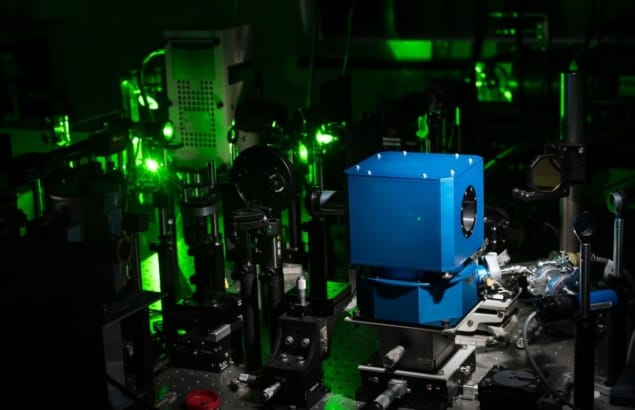
This article reports on research described in a paper in Nature. This paper has since been retracted by the journal.
Superconductivity has been observed at temperatures up to 15 °C in a hydrogen-rich material under immense pressure – shattering the previous high-temperature record by about 35 degrees. The carbonaceous sulphur hydride material was made and studied by Ranga Dias and colleagues at the University of Rochester and the University of Nevada Las Vegas in the US, who say that it may be possible to reduce the pressure required to achieve room-temperature superconductivity by changing the chemistry of the material.
Superconductors carry electrical current with no electrical resistance and have a range of applications from the high-field magnets used in MRI scanners and particle accelerators to the quantum bits used in quantum computers. Today, practical devices based on superconductors must be chilled to very cold temperatures, which is costly and can involve the use of helium – which is a limited natural resource. Therefore, a long-standing goal of condensed-matter physicists has been to develop a material that is a superconductor at room temperature.
In 2015 Mikhail Eremets and colleagues at the Max Planck Institute for Chemistry and the Johannes Gutenberg University Mainz, both in Germany, made a huge breakthrough when they observed superconductivity at 203 K (–70 °C) in a sample of hydrogen sulphide at about 1.5 million times atmospheric pressure. This new record was a huge leap forward in the quest for a room-temperature superconductor and reinforced theoretical predictions that hydrogen-rich materials could offer a way forward. Indeed, the metallic state of hydrogen – which is expected to occur at extremely high pressures and has yet to be fully characterized – is expected to be a superconductor at room temperature.
Winter’s day in Siberia
In early 2019 Eremets’ team and a group led by Russell Hemley at George Washington University in the US reported superconductivity at temperatures up to about –20 °C – a typical winter temperature across vast swathes of Russia and Canada.
Now Dias and colleagues have boosted this temperature to 15 °C, which coincidentally is the average surface temperature of the Earth. They did this by adding carbon to hydrogen sulphide – which was done by mixing methane and hydrogen sulphide together in a photochemical process. Dias told Physics World that part of his team’s success can be attributed to the precision of their synthesis technique, which is done at relatively low pressure. “[The photochemical process] is critical in introducing methane and hydrogen sulphide into the starting material, that allows just the ‘right’ amount of hydrogen needed for such remarkable properties,” he explains.
The team placed their samples in the jaws of a diamond anvil and squeezed them to pressures between about 1.4 and 2.7 million atmospheres. They found a sharp upturn in the superconducting transition temperature at about 2.2 million atmospheres with the maximum temperature of 15 °C occurring at about 2.6 million atmospheres.
Hallmarks of superconductivity
According to Dias, the team was able to make three measurements to confirm that the material is indeed a superconductor. The resistance of the sample was measured using two-probe and four-probe techniques to ensure that it was indeed zero. The researchers also measured the transition temperature as a function of applied magnetic field and found that the temperature dropped as the field increased – which is a hallmark of a superconductor. Finally, they observed that the material expelled magnetic field lines, which is another characteristic of a superconductor.

Hydrogen sulphide is warmest ever superconductor at 203 K
One shortcoming of the research may turn out to be an important opportunity: the team does not know the structure and exact stoichiometry (ratios of carbon, sulphur and hydrogen atoms) of the material at very high pressure. Dias says that the researchers have “some idea [of the stoichiometry] but don’t know the exact answer”. Determining the structure is difficult because the constituent atoms are too light so see using X-ray diffraction. “We have been developing a new set of tools to solve this problem,” says Dias. Once the team has a better understanding of the structure and stoichiometry they hope to be able to chemically tune the material to be a room-temperature superconductor at lower pressures.
Commenting on the significance of this latest result, Mikhail Eremets told Physics World, “We should keep in mind that truly room-temperature superconductor should be at ambient pressure, which will allow applications.” He adds that the high-pressure studies that began with his hydrogen sulphide work in 2015 provide important information in the search for an ambient-pressure room-temperature superconductor – which he says will be likely a ternary compound. Eremets also believes that this latest temperature record will not stand for long, pointing out that “there are predictions of [superconductivity] even above 400 K at high pressures”.
The research is described in Nature.



